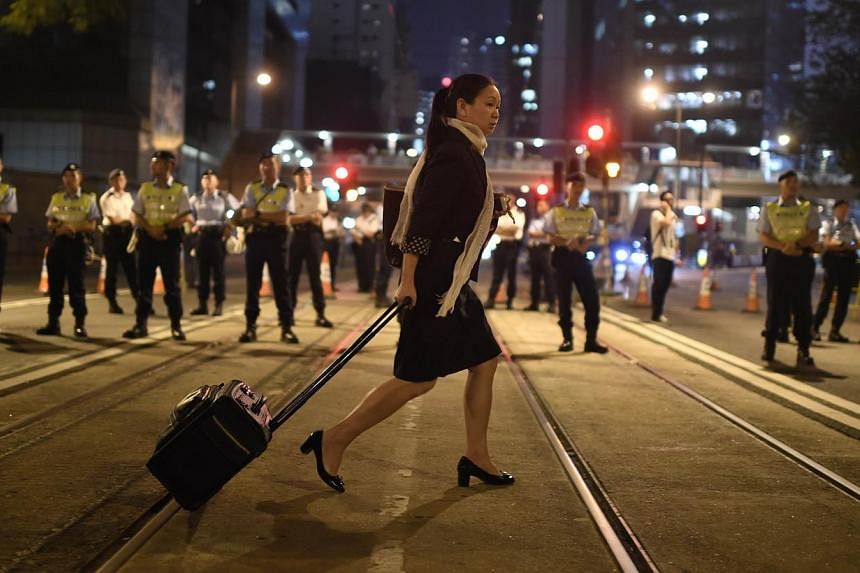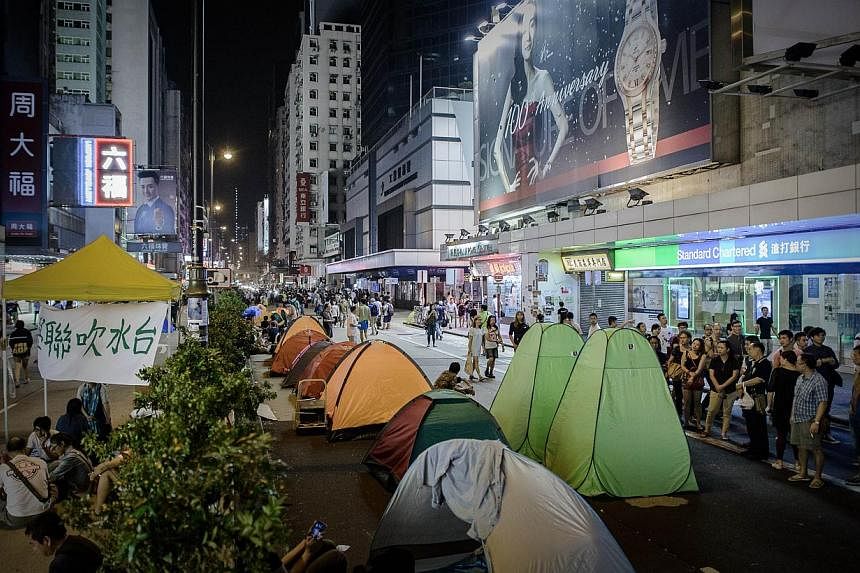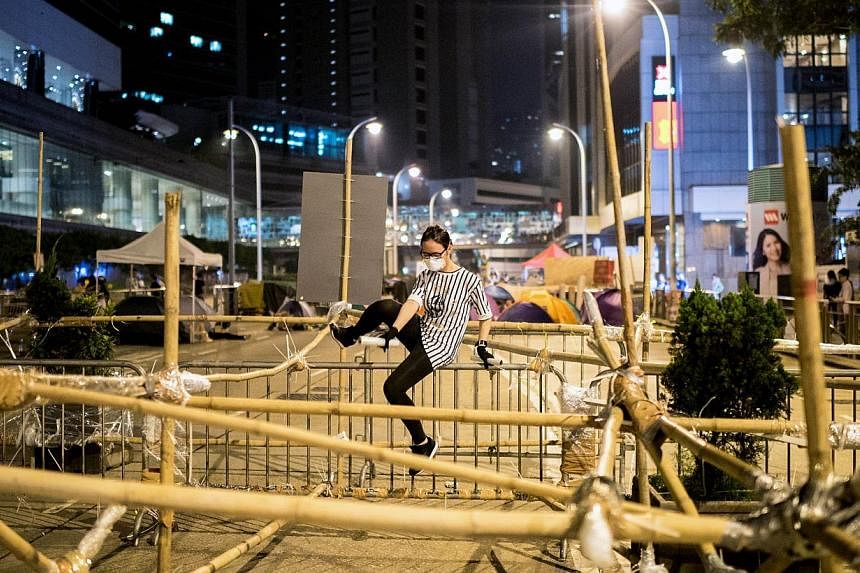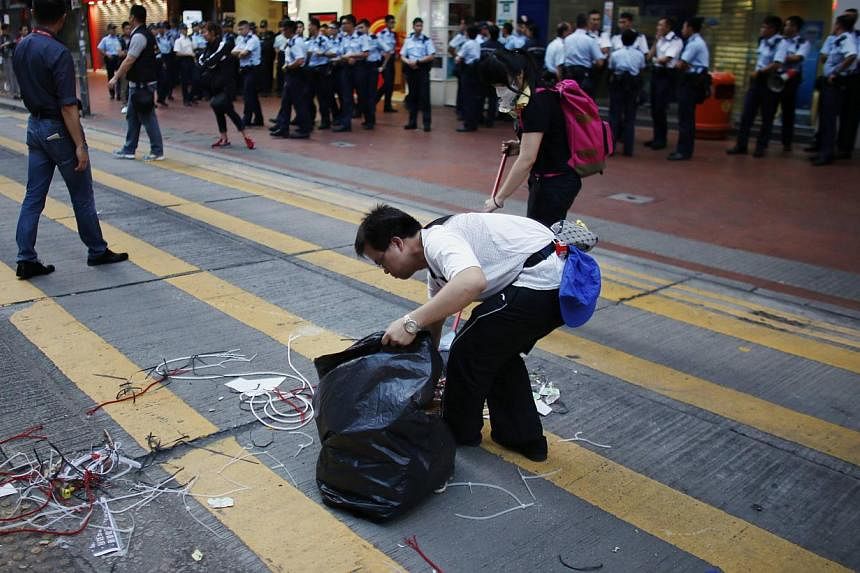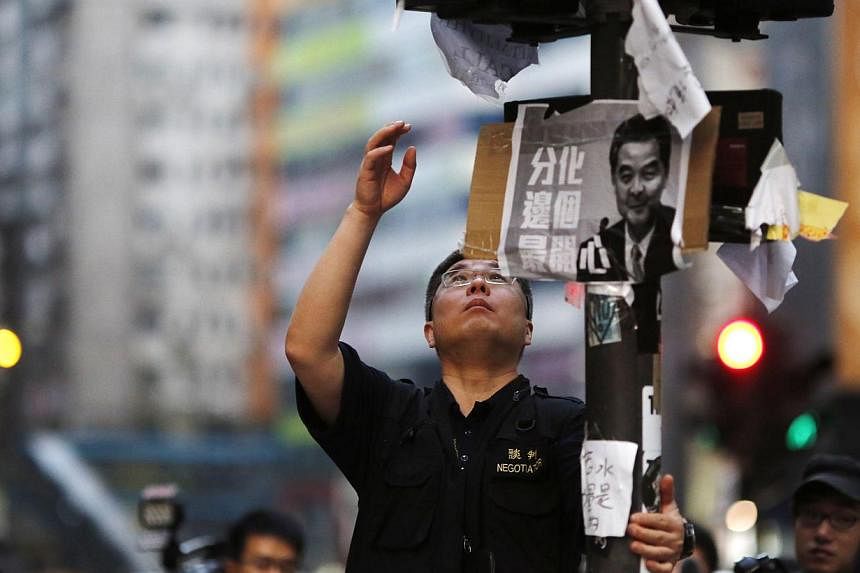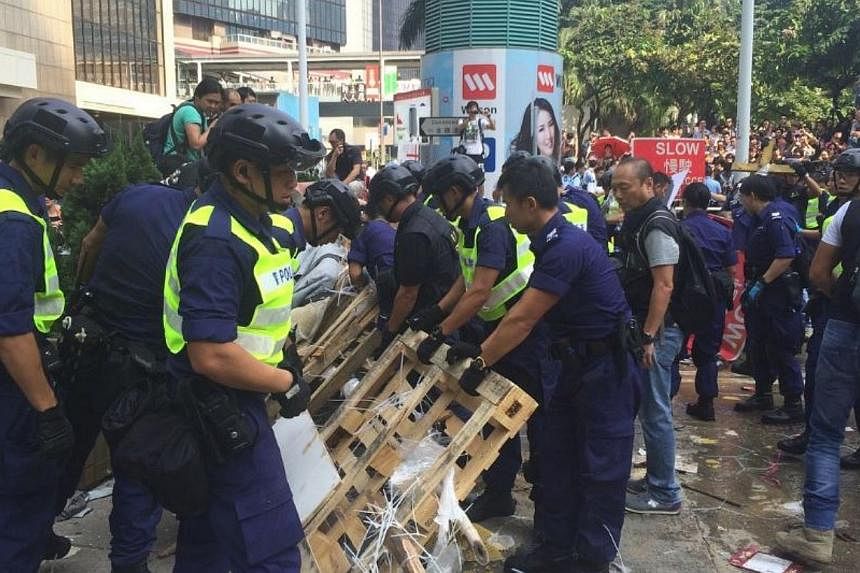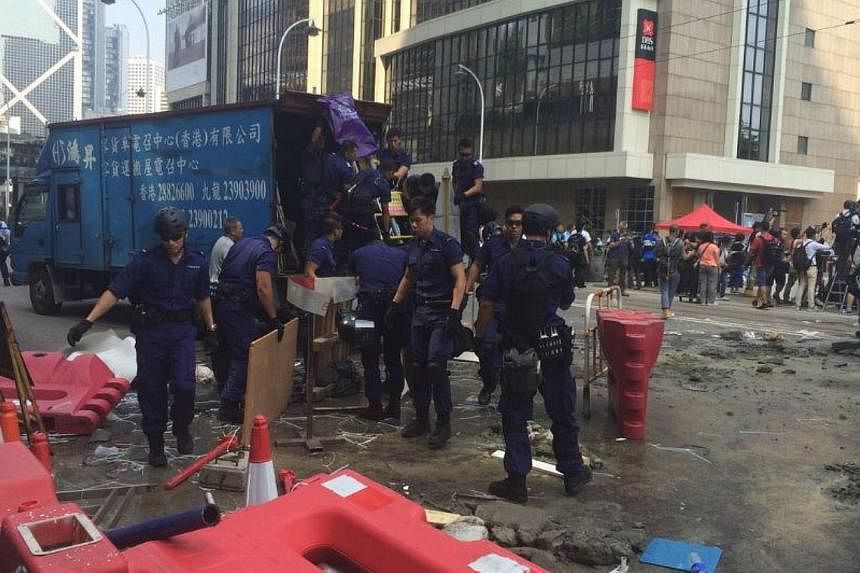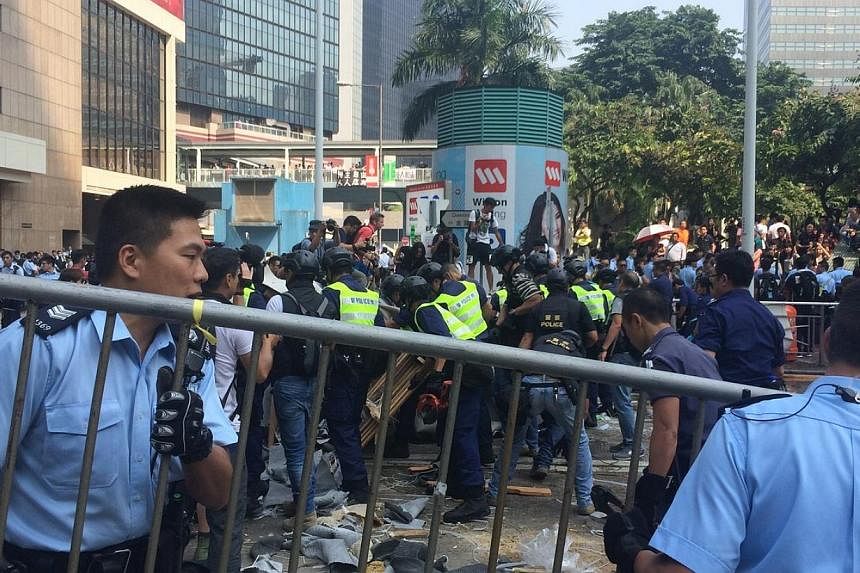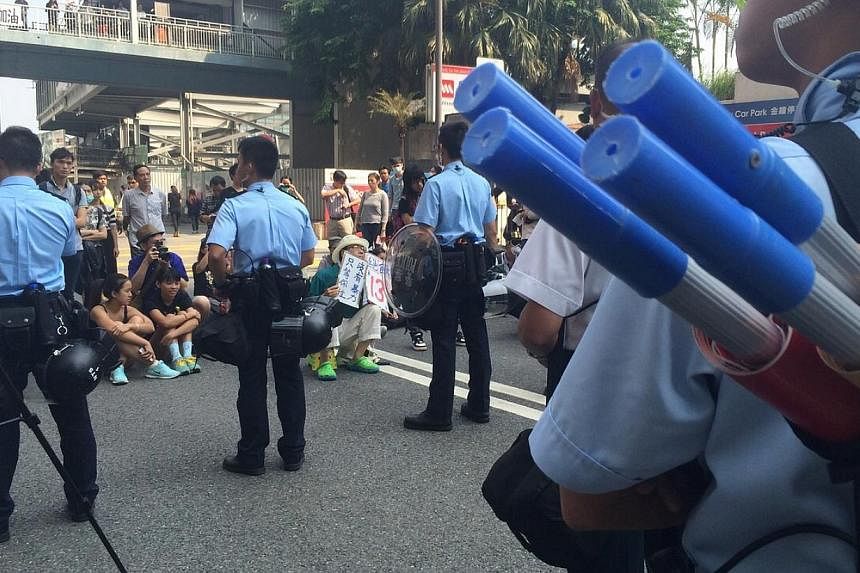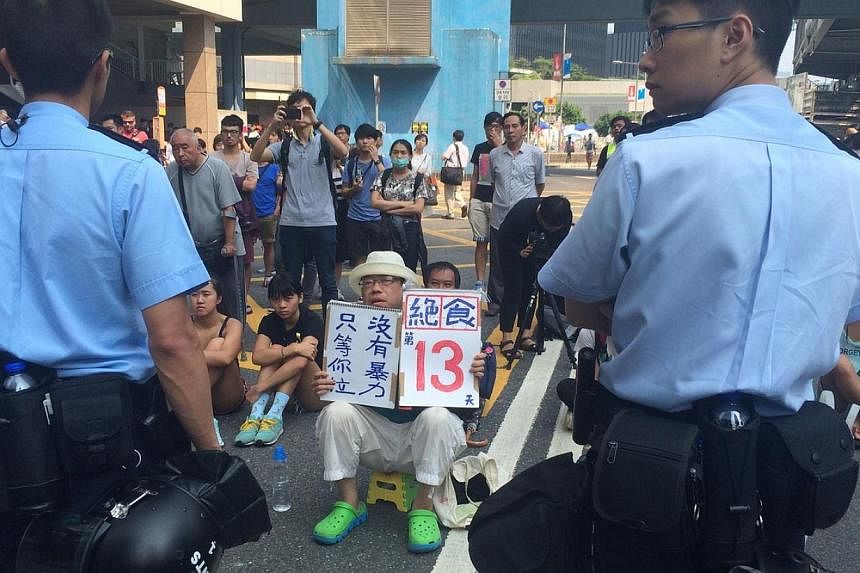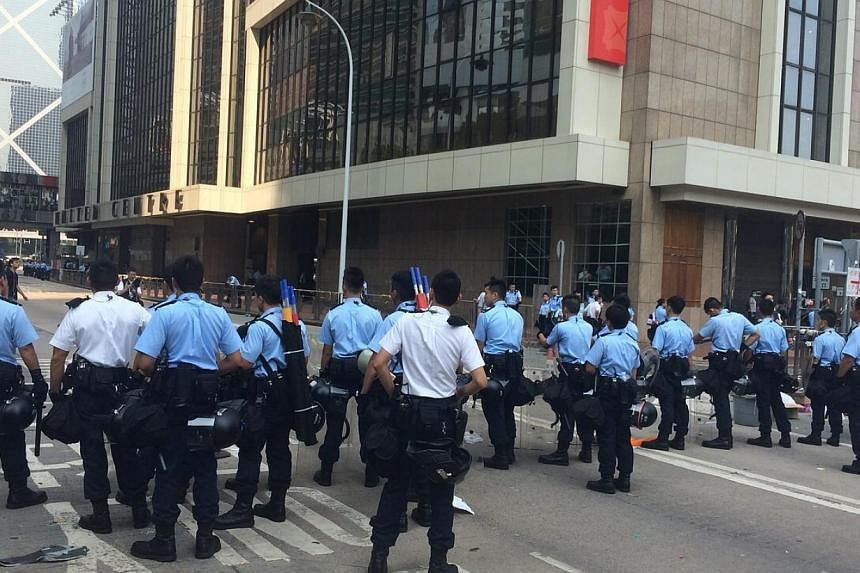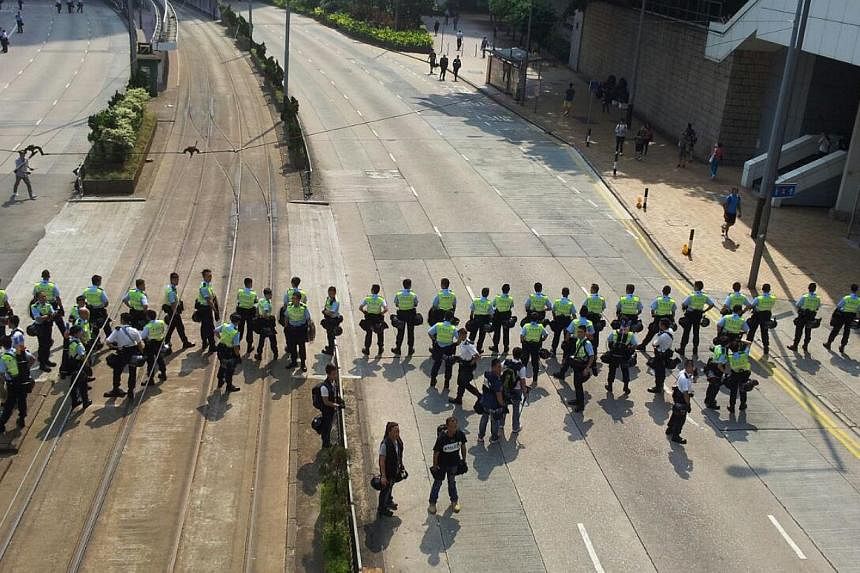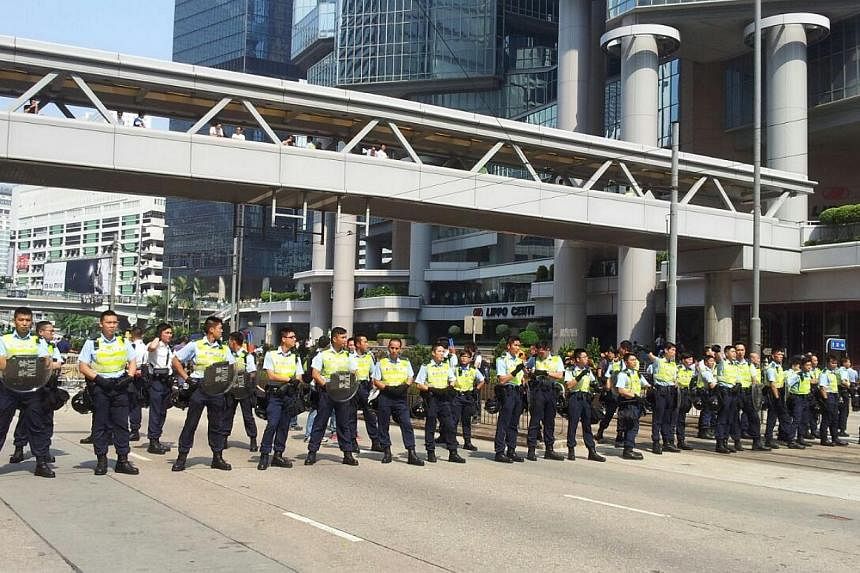HONG KONG - Police used pepper spray and detained some protesters at Admiralty on Tuesday night after the latter tried to blockade Lung Wo Road near the Chief Executive Office.
Protesters were seen wearing face masks to prepare themselves for a confrontation. But after the scuffles, police retreated from Lung Wo which is now barricaded.
Earlier on Tuesday, dozens of police removed barricades from two more Hong Kong protest sites, a day after a similar attempt at the city's main occupied area largely backfired as demonstrators rebuilt and reinforced their defences.
Around 150 police officers took away the metal barricades in the bustling Causeway Bay shopping district shortly before dawn, according to an AFP journalist at the scene. They also used chain saws to dismantle barricades of bamboo poles and dustbins at Queensway, where most government offices are located.
Around 100 officers charged down Queensway, a major thoroughfare running through the heart of the Asian financial hub, to tackle a string of barricades running across the road.
"Police have decided to take the next step in action to take away unlawful obstacles on the westbound lane and tram lines of Queensway," a police spokesman told reporters shortly before the operation started.
"We are only residents and students," one tearful young woman shouted at the police. "We will leave as we are unable to fight you, but we will not give up."
Officers used clippers to slice through the myriad of plastic ties that protesters had used to lash railings and bamboo poles together, and also removed protester tents, an AFP reporter said. Some protesters were seen sobbing. "We are only residents and students," one was heard shouting at police. "We will leave as we are unable to fight you but we will not give up."
Cable TV also showed police using chainsaws and circular saws to slice through bamboo poles.
Police told reporters that the operation was limited to removing barricades along Queensway to free up traffic.
They added protesters still had space to express their views on Harcourt Road, the major thoroughfare opposite the city's main legislative headquarters which has formed the epicentre of the ongoing protests.
By noon on Tuesday, Queensway Road was reopened, allowing traffic, including school and tour buses, to flow straight through to the Central business district that is home to global companies such as HSBC Holdings and Standard Chartered.
Outside the Lippo Centre in Admiralty district, a driver of one of the city's ubiquitous red taxis shouted angrily at the protesters that they were making it impossible for him to make a living.
The crowd responded by singing "Happy Birthday", which has become the movement's signature way of diffusing tense situations, including when minor clashes have broken out with those opposed to the demonstrators.
Protesters said the police operation at Causeway Bay began shortly after 5am, and that officers told demonstrators they were allowed to stay but needed to vacate one of the main roads they were occupying.
"They just said the cars are going to come later and that they're not trying to remove us. They've said we can stay. We have to be calm, we've got about 15 people and there are more than 100 cops here," Mr Billy Lee, a 36-year-old protester manning one of the barricades, told AFP.
Protest leader Alex Chow rallied supporters at Causeway Bay, and called on the city's Chief Executive Leung Chun Ying - whose resignation protesters are demanding - to restart stalled talks after the government abruptly pulled out last week.
"The Occupy movement will not retreat, there is no way to retreat right now... as long as Leung doesn't give a concrete solution, all the occupiers will not leave," said Chow, president of the Hong Kong Federation of Students.
Causeway Bay, a district packed with luxury stores popular with tourists from mainland China, has become the scene for a major protest camp for more than two weeks.
Demonstrators set up camp over a major east-west thoroughfare which usually carries buses, cars and trams, disrupting traffic and angering many locals who said business was being affected.
The police removal operation appeared to target a single lane of traffic heading west into the city centre. The tram lines and main routes heading east were still being held by protesters.
Similar scenes had taken place on Monday in Causeway Bay, which is one of the three main sites occupied by pro-democracy demonstrators who have paralysed parts of the city over the past fortnight.
Demonstrators erected a new barricade, filling buckets with concrete to place the feet of metal barriers inside and reinforcing their line with hundreds of plastic ties.
But the modifications did little to stop the police from pulling the main barricades down on Tuesday.
Police had started moving in to clear barriers at the edges of the main protest site in Admiralty on Monday, catching some demonstrators unawares after their numbers had dwindled overnight.
Activists laid down cement foundations and built up bamboo pole barricades blocking both lanes of a highway, using everything from steel chains to plastic ties and sticky tape to strengthen the structures, even enlisting sympathetic construction workers for help with their building work.
The atmosphere remained calm as police armed with bolt cutters and wire clippers sliced through plastic ties holding the barricades together, and ripped down banners with pro-democracy slogans on a bridge overlooking the site.
Although the police action cleared one side of the road, protesters remained in control of the the eastbound carriageway running through the district as well as two tram lines.
Meanwhile, over 100 people besieged the offices of the Apple Daily newspaper on Tuesday night for the third consecutive night, in an effort to halt the running of the paper, according to the South China Morning Post (SCMP).
The protesters, most of whom were women wearing facemasks, voiced their rage against what they said was Apple Daily's positive coverage of the pro-democracy protests.
The High Court has ordered the group to leave the area, and police officers tried to separate them from the newspaper's staff, but no arrests have been made, reported SCMP.
At 3am on Tuesday morning, the protesters were blocking the main entrance, preventing delivery trucks from entering.
On Monday, masked men rushed the rebuilt barricades in Admiralty, sparking renewed accusations that authorities are using hired thugs to disperse demonstrators.
Demonstrators, who have come under attack from organised crime gangs known as triads at another flashpoint demonstration site in Mongkok, shouted: "Weapons! Weapons!" and "Arrest the triads" as police struggled to impose order.
Taxi drivers also converged on the site with their cars, demanding the barricades be removed and other anti-Occupy groups chanted "Occupy is illegal".
Students and pro-democracy campaigners have taken to the streets - sometimes in their tens of thousands - since last month to call for Beijing to change its position on allowing unfettered elections and to demand the resignation of the city's Chief Executive Leung Chun Ying.
Despite repeated orders to disperse, the sit-ins have taken on an air of permanence, with tents, portable showers and lecture venues springing up in recent days.
On Monday, embattled leader Leung had told reporters in the Chinese city of Guangzhou that he wanted the protests to end.
"Under the appropriate situation we hope to allow society to return to normal as quickly as possible," he said on the sidelines of a trade meeting.
With contributions from AFP
